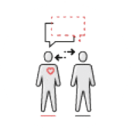
A collaborative approach to patient-centric clinical Research

In today’s world, empowered patients are more interested in taking ownership of their health and how it is managed. This is also an era when pharmaceutical science is making great advancements in the development of life-changing treatments. Traditionally, a patient’s involvement in drug development was limited to clinical trial participation.
While this is a necessity for product efficacy and safety testing, there is a vast range of additional scientific and medical communication activities that take place outside of clinical trials and these have not traditionally directly involved patients. Regulatory authorities across the globe have taken note of these factors and are now pushing for increased patient involvement and consultation broadly throughout the drug development continuum.
With leadership from both the US Food and Drug Administration (FDA) and the European Medicines Agency (EMA), it is essential that researchers, study sponsors, and all invested parties in the development of pharmaceutical products and medical devices adopt innovative patient engagement strategies. The creation of patient advisory groups allows for input from those living with a disease to give researchers perspective on treatment gaps, preferred methods of treatment, challenges with typical clinical trial processes, and sharing of information and key findings.
Patient inclusivity in clinical research
While industry experts agree that increased patient engagement is essential, the implementation of strategies is lacking. Determining effective methods of engaging patients in the design and control of clinical research studies is fairly new. It requires that all parties ensure “meaningful and effective patient participation” in the research.(1) Patient engagement can be considered in all aspects of the research process, from setting research priorities, to developing study protocols and conducting trials, to post-research communication. Early studies have suggested that patient engagement increases patient recruitment speed and time to market.(2)
Improved trial enrollment, adherence, and retention, stemming from improved patient engagement, may have considerable financial value.(3)
Concepts of patient centricity are defined by Deloitte as “the process of developing positive healthcare outcomes through direct engagement with patients.” It is learning how the patient experiences their condition, and what they see as important values and needs.(4)

SETTING RESEARCH PRIORITIES
Understanding methods to involve patients and the public in research
- Create patient engagement advisory groups
- Align goals, values, expectations of patient population
- Identify patient needs to improve quality of life

STUDY DESIGN AND EVELOPMENT
Assess options and incorporate input from patient advisory groups
- Study endpoints and patient-reported outcomes
- Patient acceptability of study procedures and visit schedule
- Drug administration, recommendations, delivery, and insights

KEEPING PATIENTS ENGAGED
Ensuring ongoing flow of patient-directed information and tools to keep momentum
- Trial information to drive recruitment
- Tools to support trial retention
- Development of patient network (e.g. online forums and groups) to share insights

POST
RESEARCH
Focus on transparency of communication and sharing of information
- Full disclosure of trial results in language understandable to the lay public
- Updates on drug or device approval
- Offering two-way communication to allow patient feedback
Establishing research goals
A considerable gap often exists between the goals of a researcher in a lab and those of a person living with a disease. Prior to identifying research goals, consultation with patients can offer insight into research and treatment gaps. These individuals may be considered experts on their disease and bring with them a wealth of suggestions that current treatment options may have missed. Their insights and perspectives can be used to shape realistic and relevant study objectives that align with the goals, values, and expectations of the patient population. Through the formation of patient advisory groups that offer input throughout the entire process, research can focus on strategies that identify and address patients’ unmet needs to improve outcomes and their quality of life.
Study design and development
During the design and planning phases of a clinical trial, large amounts of time are spent consulting with key investigators, gathering input and considering the full impact of research on the patients who would be involved.
A recent study conducted by Accenture found that only 47% of surveyed patients believed that pharmaceutical organizations understood the emotional, financial, and logistical requirements related to their condition. This implies that when developing research protocols and project plans, sponsors could incorporate input from patient advisory groups or include them in trial steering committees.(5) Collecting opinions and disseminating information to patients could be facilitated digitally through online discussion forums, questionnaires, and informative newsletters outlining upcoming opportunities for research and input.(3) These discussions with patient populations can facilitate identification of the most relevant study endpoints and patient-reported outcomes (PROs), clinically relevant inclusion/exclusion criteria, and study comparators.
Furthermore, patient consultation can also help increase patient willingness to participate in research, as feedback around the proposed methods of drug delivery (tablet vs. injection), the number of required clinic visits and associated costs, and the clarity and accessibility of research information can be used to shape the early stages of protocol development. With this information available, study organizers can customize tools that might translate to fewer study visits and more effective and efficient communication.(6)
A greater understanding of the participant’s time and openness to communication via digital channels and remote access technologies, for example, could have a major impact on trial length and success.
Keeping patients engaged
Once a trial is underway, patient engagement is at its peak, but there is more to be gained from further involvement. Patients in a trial are stakeholders, and their experience and input can shape the communication process and flow of information. Making a research study more appealing to patients might be achieved by incorporating strategies such as:(7)
- Gaining a specific understanding of the trial’s target audience, taking time to consider their limitations and objectives
- Surveying patients and caregivers to determine how a proposed protocol would be received by the patient
- Scanning online forums and disease groups to gather information on patient frustrations and goals
- Identifying and mitigating the potential deterrents of participating in a study. Most people have no experience with clinical trials and may not fully grasp the expectations prior to consenting to participate
- Simplifying the language used in communication materials. Consent forms and informational brochures can be long and filled with medical jargon not well understood by all audiences
- Gathering PROs relating to state of mind, general health, or adverse events from ongoing study subjects
- Communicating rationales behind the protocol and amendments
With further refinement and tracking of information, patient engagement could improve both recruitment and retention throughout a study.
Post-research
For investigational products, study completion often means a temporary “end-of-the-road” for patient use of the medication or device, and a return to standard of care. In the meantime, investigators remain in contact with the sponsor team and study staff, have access to scientific publications or journals, and are provided with summary reports from the sponsor. It takes time for this information to be disseminated through the medical community and become a more digestible, comprehensive version. Sponsors could change this process by communicating with former subjects after study completion with updates on drug or device approval, successes and failures of other trials, and offering two-way communication. Requesting feedback from patients regarding their time in the study and their experiences after discharge could offer valuable insight into the positives and negatives of the study. Patient engagement can continue into the commercialization phase, by seeking insight to ensure that packaging inserts and safety communications are unambiguous to the product users.(8) The Centre for Information and Study on Clinical Research Participation (CISCRP) reported that most patients want to know the results of the research, and yet few receive any follow-up information.(9)
Maintaining transparency throughout the whole process and maintaining ongoing dialogue with trial participants allows them to feel valued and included.
Patient education and advocacy
To help support and prepare patients eager to partake in advisory roles, several innovative education and advocacy groups have been established. These organizations drive research and guide policy decisions that can assist with the incorporation of patient-inclusive initiatives. PARADIGM (Patients Active in Research and Dialogues for an Improved Generation of Medicine) is a European partnership comprised of collaborators from 34 public and private groups, including patient organizations, regulatory bodies, and pharmaceutical companies.
Engaging patients throughout the research process by filling knowledge gaps, making tools available to those who need them, and raising awareness, they are working to establish a group of expert patients’ advisors.(10) EUPATI (the European Patients’ Academy), which is an IMI (Innovative Medicines Initiative) project, aims to educate and arm patients with the knowledge and capacity to better understand the clinical trial process and provide understandable information for the general public.(11) The James Lind Alliance in the UK (12) and PCORI (the Patient-Centered Outcomes Research Institute)(13) in the US are non-profit organizations that bring patients and clinicians together to align on research priorities and questions.
With the development of these agencies, and other similar forums for learning and growth, the avenues for ensuring effective patient engagement are growing.
Regulatory requirements for patient engagement
As the trend towards patient-focused drug development grows, regulators are on track to implement requirements for research-based projects to include patients in all steps of the process. In 2015, the FDA established the Patient Engagement Advisory Committee (PEAC). The group, comprised of patients, caregivers and members of advocacy organizations and experts from industry has been brought together to discuss patient engagement issues and developments.(14) The PEAC provides the resources to integrate patient perspectives into the regulatory process.(15)
Also in progress is the development of a series of FDA Patient-Focused Drug Development guidance papers (expected to be released in 2021). Their purpose is to “facilitate the advancement and use of systematic approaches to collect and use robust and meaningful patient and caregiver input that can better inform medical product development and regulatory decision making.”(16)
The EMA similarly established a framework to work with both patients and consumers in Europe in 2014. The collaboration with patients aims to ensure increased transparency and trust between the parties. The EU Clinical Trials Regulation applied in 2017 promoted increased transparency on clinical trials and the data generated, and for more involvement of the public and patients. Notably, the regulation included the mandatory inclusion of a patient into the testing team and publication of a final report in easy-to-understand language. Among other pilot projects, the EMA established a patient application process whereby individual patients acting as “disease experts” could apply to join a pool of collaborators.(17)
Regulatory initiatives that encourage the pharma industry to incorporate the patient voice in clinical research will drive research success and have positive impacts across all stakeholders.

SUMMARY
The implementation of a patient-centric approach to clinical research offers researchers a window into the minds of their subjects.
By leveraging patient's experience and expertise, recruitment, retention, study feasibility, and results can all be improved.
Strategic implementation of patient engagement strategies and tools can be highly effective in ensuring transparency and open communication in the research process.
By engaging patients throughout the drug development continuum, they are empowered with the ability to manage the future of their health and that of their peers, allowing them to participate in the forefront of scientific breakthroughs.
Therapeutic Areas
METABOLIC DISORDERS
ONCOLOGY
DERMATOLOGY
DIABETES
RHEUMATOLOGY
CARDIOVASCULAR
NEUROLOGY
ENDOCRINOLOGY
HEMATOLOGY
PLASMA DERIVED THERAPIES
RADIOLOGY
BACTERIOLOGY
FERTILITY
OPHTALMOLOGY
GYNECOLOGY
WOMEN’S HEALTH
SLEEP
PAIN
PEDIATRICS
VIROLOGY
HIV/AIDS
MUSCULOSKELETAL
OBESITY
IMMUNOLOGY
OBESITY
PSYCHIATRY
ORTHOPEDICS
OBSTETRICS
OTOLARYNGOLOGY
OSTEOPOROSIS
VACCINES
GENETICS
PULMONARY
ADDICTION
MICROBIOME
REPRODUCTION
ANTI-FUNGALS
NEPHROLOGY
SEXUAL DYSFUNCTION
STEM CELL THERAPY
REFERENCES
1 Applied Clinical Trials, “Models of Engagement: Patients as Partners in Clinical Research”
http://www. appliedclinicaltrialsonline.com/models-engagement-patients-partners-clinical-research
2 The Economist. “The Innovation Imperative”, https://druginnovation.eiu.com/
3 Levitan B et al. Ther Innov Regul Sci 2018;52:220–9
4 Deloitte, “Pharma and the connected patient”
https://www2.deloitte.com/global/en/pages/life-sciences-and-healthcare/ articles/pharma-and-connected-patient.html
5 Pharmaphorum, “Why pharma isn’t collaborating with patient organisations as much as it should”
https:// pharmaphorum.com/views-and-analysis/why-pharma-isnt-collaborating-with-patient-organisations-as-much-as-itshould/
6 Deloitte, “Digital R&D: Four ways to maximise patient engagement in clinical trials”
https://blogs.deloitte.co.uk/ health/2018/08/digital-rd-four-ways-to-maximise-patient-engagement-in-clinical-trials.html
7 Drug Development and Delivery, “How to Make Clinical Trials Patient Centric: Five Common Sense Steps”
https://drugdev. com/clinical-trials-how-to-make-clinical-trials-patient-centric-five-common-sense-steps/ (applicable to bullets 1-5)
8 Geissler J et al. Ther Innov Reg Sci 2017;51:612–9.
9 NIH, “Clearly Communicating Research Results across the Clinical Trials Continuum”
https://www.nih.gov/healthinformation/ nih-clinical-research-trials-you/clearly-communicating-research-results-across-clinical-trials-continuum
10 EPF, “Paradigm: a unique collaboration for better patient engagement in medicines development”
http://www.eupatient. eu/News/News/paradigm-kicks-off/
11 NCBI, Frontiers in Medicine, “EUPATI Guidance for Patient Involvement in Medicines Research and Development (R&D); Guidance for Pharmaceutical Industry-Led Medicines R&D”, https://www.ncbi.nlm.nih.gov/pmc/articles/PMC6190844/
12 James Lind Alliance, http://www.jla.nihr.ac.uk/
13 Patient-Centered Outcomes Research Institute, https://www.pcori.org/
14 FDA, “CDRH Patient Engagement Advisory Committee”
https://www.fda.gov/about-fda/cdrh-patient-engagement/ cdrh-patient-engagement-advisory-committee
15 FDA, “Charter of the Patient Engagement Advisory Committee to the Food and Drug Administration”
https://www.fda. gov/advisory-committees/patient-engagement-advisory-committee/charter-patient-engagement-advisory-committeefood- and-drug-administration
16 FDA, “FDA Patient-Focused Drug Development Guidance Series for Enhancing the Incorporation of the Patient’s Voice in Medical Product Development and Regulatory Decision Making”
https://www.fda.gov/drugs/development-approvalprocess- drugs/fda-patient-focused-drug-development-guidance-series-enhancing-incorporation-patients-voice-medical
17 EMA, ‘Revised framework for interaction between the European Medicines Agency and patients and consumers and their Organisations”
https://www.ema.europa.eu/en/documents/other/revised-framework-interaction-betweeneuropean- medicines-agency-patients-consumers-their_en-1.pdf
References in this article.

